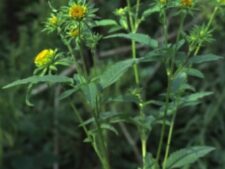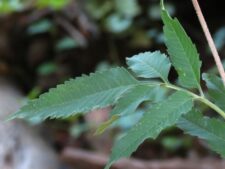
TALL BEGGAR TICKS
Bidens vulgata
SUNFLOWER FAMILY (Asteraceae)
 Identification
Identification
- Flowering time - August, September, October
- Rare along streams or wet ditches at FF, NW
- Leaves divided into 3-5 leaflets
- More than 10 leafy bracts at base of flower
- Very similar to B. frondosa - see Comments
Very similar to Devil’s Beggar ticks (Bidens frondosa), except it has many more bracts, from 10-15 or more as shown in images (A and B). The leaves have 3-5 toothed leaflets (E). This species grew to 5 feet tall during the summer of 2012 (D), a year after the big flood. Identified positively with the help of Biology Professor Emeritus Dave Sutherland of UNO.
Common according to “Flora of Nebraska”, but not seen/identified in Fontenelle Forest or Neale Woods in recent years before or after the big flood. Look for it in wet places on the floodplain.
Devil’s Beggar Ticks (B. frondosa) and Tall Beggar Ticks (B. vulgata) have once divided leaves with 3-5 leaflets separating them from the the other 3 Bidens species that have been identified recently at Fontenelle Forest and Neale Woods. Their seeds also quite consistently have only 2 barbed awns; the others have either very different elongated needle-like seeds or similar seeds with 3 or 4 awns. Devil’s and Tall Beggar Ticks are quite similar and separating these may not always be possible. As the common name suggests, Tall Beggar Ticks is generally a taller, more robust plant with larger central flower heads, but the most reliable way to separate them is to look at the leafy bracts lying just below the flower head. Devil’s Beggar Ticks has fewer (5-9), more delicate bracts while Tall Beggar Ticks has 10 or more.
The content of NatureSearch is provided by dedicated volunteer Naturalists of Fontenelle Forest who strive to provide the most accurate information available. Contributors of the images retain their copyrights. The point of contact for this page is: Roland Barth.




